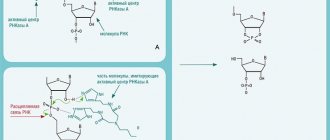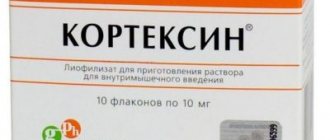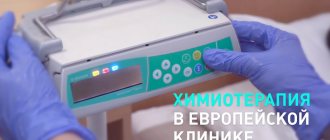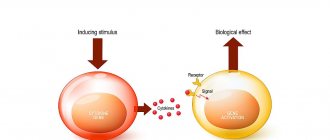The nootropic drug Cortexin was developed by domestic scientists in 1999. Initially, it was used to restore military personnel after concussion. After additional research, the effectiveness of the drug in treating various neurological pathologies was proven.
The medicine is a lyophilisate powder. It has a recognizable slightly yellowish tint, but can sometimes be white. An injection solution is prepared from the powder for further intramuscular administration. The main active component is polypeptide neuroactive complexes. The auxiliary ingredient is glycine.
You can purchase Cortexin injections for adults and children. The drugs differ in dosage. Cortexin injections, the price of which is 700 - 1300 rubles per pack, improve microcirculation in brain tissue. When used, memory improves and performance increases.
Cortexin Lyof for IM solution 10 mg cor x10
Trade name: Cortexin International name: Livestock cerebral cortex polypeptides
Release form: lyophilisate for the preparation of solution for intramuscular administration 10 mg (bottles)
Composition: polypeptides of the cerebral cortex of cattle [cortexin] 10 mg
Pharmacological group: nootropic agent
Pharmacological group according to ATK: N06BX (Psychostimulants and other nootropics)
Pharmacological action: antioxidant, brain hydrolyzate, nootropic, stimulating protein synthesis in the central nervous system,
Description: Cortexin is a polypeptide drug obtained by extraction from the cerebral cortex of cattle and pigs. In medical practice, it is used in the form of a clear, colorless solution, which is prepared from white lyophilized powder.
Indications: - cerebrovascular accidents, - encephalopathies of various origins, - acute and chronic encephalitis and encephalomyelitis, - vegetative-vascular dystonia, - epilepsy, - traumatic brain injury, - viral and bacterial neuroinfections, - cerebral palsy, - psychomotor and mental retardation. speech development in children, asthenia, impaired memory, thinking, decreased learning ability.
Dosage regimen: For adults, the drug is prescribed intramuscularly at a dose of 10 mg 1 time/day for 5-10 days. If necessary, repeat the course after 1-6 months. In children weighing less than 20 kg, the drug is used at a dose of 0.5 mg/kg body weight, in children weighing more than 20 kg - 10 mg/day. The drug is administered intramuscularly 1 time/day for 10 days.
Rules for preparing the solution The contents of the bottle are dissolved in 1-2 ml of a 0.5% solution of novocaine, water for injection or isotonic sodium chloride solution.
Contraindications: Individual intolerance to the drug, pregnancy.
Side effects: When used according to indications in recommended doses, no side effects were detected. Currently, no cases of overdose of the drug Cortexin have been reported.
Pharmacodynamics: A drug that improves brain metabolism. Cortexin is a lyophilisate obtained by acetic acid extraction from the cerebral cortex of cattle or pigs, containing low molecular weight active neuropeptides, the molecular weight of which does not exceed 10,000 daltons, sufficient to penetrate the BBB. Cortexin has a tissue-specific multifunctional effect on the brain, which is manifested in metabolic regulation, neuroprotection, functional neuromodulation, and neurotrophic activity. Cortexin increases the efficiency of energy metabolism of brain cells and improves intracellular protein synthesis. Cortexin regulates the processes of lipid peroxidation in brain cells, reduces the formation of free radicals, and blocks the processes of free radical oxidation. The drug eliminates the imbalance of inhibitory and excitatory amino acids and has a moderate GABA-ergic effect. The drug has a positive effect in cases of impaired cognitive function, improves concentration, short-term memory, learning ability, accelerates the recovery of brain function after stressors, regulates the level of serotonin and dopamine. Stimulates the process of mental activity without exerting an excessive activating effect, restores the bioelectrical activity of the brain. Cortexin stimulates reparative processes in the brain.
Pharmacokinetics: The complex composition of Cortexin, consisting of biologically active neuropeptides containing 20 amino acids and having a total multifunctional effect, does not allow for conventional pharmacokinetic analysis of individual components.
Special instructions: Pregnancy and lactation The drug is contraindicated for use during pregnancy. It is possible to use the drug during lactation according to indications.
Storage conditions: List B. In a dry place, protected from light, at a temperature of 2 to 20 degrees. WITH.
Shelf life: 3 years.
Dispensed from pharmacies: Dispensed by prescription.
Drug registration number: P No. 003862/02
Date of registration (re-registration) of the drug: December 21, 2004
Cortexin®
This term is often found in medical publications, the media, and in advertising of medicines. The possibilities of neuroprotection are inherent in the very nature of the brain, in genes, at the level of regulatory neuropeptides. The essence of neuroprotection is that the treatment process not only helps protect the affected group of neurons, but also ensures its further functioning. An important question for medicine is: are there adequate pharmacological effects that can trigger these natural mechanisms and maintain them at the required level? In this regard, the search, creation and testing of new pharmaceuticals are and will be one of the most important areas of modern pharmacology.
It is obvious that the search for new neuroprotectors is a complex process that requires the combined efforts of doctors, biologists, and pharmacologists at all stages. In this regard, preparations of peptide nature deserve special attention. Despite their diversity, they are united by a number of common characteristics: low dosage, absence of pronounced toxic effects, gentleness and duration of exposure. In general, it can be argued that the body’s peptide system (Koroleva S.V., Ashmarin I.P., 2006), formed over millions of years of evolution, provides multi-level regulation of all functions, including processes that ultimately lead to a neuroprotective effect . In terms of information, it is peptides that are a universal language, understandable and natural for living organisms both at the systemic level and at the cellular level.
One example of a successful development based on the principles listed above is Cortexin, a drug whose effectiveness has been proven at all possible levels of research: clinical, biological, cellular, genetic and molecular.
According to MRI data, a lesion is identified in the right temporal region of the brain, the volume of which clearly increases by the 3rd day. With such a lesion, the formation of a glial scar and post-stroke cysts is usually observed on day 28. When using Cortexin, when a patient with an ischemic stroke begins to receive the drug from the first hours of the disease, along with a noticeable improvement in general well-being, clinical and neurological picture, the volume of the brain lesion by 28 days decreases by 40%. This observation illustrates the striking effect of the neuroprotective action of Cortexin (Skoromets A.A., Skvortsova V.I. et al., 2008).
Terminology: Ischemia - Insufficient blood supply to any organ or tissue area caused by blockage or narrowing of the corresponding artery; ATP - Adenosine triphosphate - a nucleotide that plays an extremely important role in the exchange of energy and substances in organisms; First of all, the compound is known as a universal source of energy for all biochemical processes occurring in living systems. Depolarization of the cell membrane is a change in the electrical potential on the cell membrane; Glutamate is an amino acid and the main excitatory neurotransmitter. The binding of glutamate to specific neuronal receptors results in neuronal excitation. NMDA and AMPA glutamate receptors are receptors that ensure the conduction of an excitatory impulse by neurons when glutamate is bound; Caspases and NO synthases are intracellular enzymes involved in the processes of cell death and the development of oxidative stress.
Neuroprotective anti-apoptotic effect
Cortexin ® is a neuroprotector that has a therapeutic effect starting from the first hours after ischemic brain damage. This means that its main target is the penumbra zone - a section of nervous tissue surrounding the lesion, experiencing oxygen and energy starvation, but temporarily, up to 6 hours, remaining alive. The possibility of subsequent restoration of nervous functions, life and death of the patient depends on the outcome of this process. Cortexin ® affects all links in the pathological chain of molecular events leading to the death of neurons. Cortexin ® to reduce the level of neuronal apoptosis (programmed cell death) caused by excessive accumulation of glutamate (Pinelis et al., 2008).
Glutamate is the main excitatory neurotransmitter of the nervous system. During a stroke, glutamate is released excessively, triggering a cascade of processes that underlie neuronal death. In the culture of nervous tissue, the introduction of glutamate into the medium also leads to the death of neurons. If a substance with a neuroprotective effect is administered simultaneously with glutamate, the death of neurons is reduced. This figure shows the results of a study of the neuroprotective properties of Cortexin ® in vitro: when administered simultaneously with glutamate, Cortexin ® has a pronounced neuroprotective effect in the nanogram concentration range (* p < 0.05 compared to the control group) (Granstrem O.K. et al. , 2008).
Restoration of ATP synthesis
Adenosine triphosphate (abbr. ATP) is a nucleotide that plays an extremely important role in the metabolism of energy and substances in organisms, a universal source of energy for all cells of the body. A decrease in the ATP content in brain cells is the central link in all pathological processes occurring against the background of cerebral ischemia. A decrease in synthesis and an increase in ATP consumption is shown immediately after the onset of ischemia of nervous tissue (Sorokina et al., 2007). Recent studies have demonstrated that Cortexin ® is capable of restoring ATP content in neurons.
The study demonstrated the ability of Cortexin ® to trigger the processes of natural ATP recovery in the mitochondria of nerve cells. Since a drop in ATP levels is one of the main reasons leading to the death of nerve cells during stroke, the restoration of this indicator under the influence of Cortexin ® explains its clinical effectiveness (Granstrem O.K. et al., 2008).
Suppression of delayed calcium dysregulation (DCD)
During cerebral ischemia and stroke, active penetration of calcium ions into neurons occurs, which leads to an irreversible increase in their concentration in the cell and subsequent disruption of mitochondrial functioning associated with a drop in mitochondrial potential (ΔΨm) (Khodorov et al., 2001; Krieger C. & Duchen MR , 2002). As a rule, cells in which ΔΨm collapse occurs do not restore their original potential after glutamate withdrawal and ultimately die—the so-called delayed calcium dysregulation (DCD) occurs (De Wied D., 1997; Sorokina E. G. et al. ., 2007).
Fluorescence microscopy studies of mitochondrial potential (ΔΨm) demonstrate that Cortexin significantly slows the development of delayed calcium dysregulation under the influence of glutamate. The recording of mitochondrial potentials of neurons shown in the figure indicates the sparing, protective effect of Cortexin ® by delaying the onset of calcium dysregulation. Thus, it has been proven that the use of Cortexin ® can expand the therapeutic window for ischemic damage to nervous tissue (Report on the study of the neuroprotective effects of Cortexin ® , State University Scientific Center for Children's Health of the Russian Academy of Medical Sciences, Moscow, 2008).
Neurotrophic effect
® peptides have direct and indirect neurotrophic effects on cells. The main mechanisms of this influence are based on changes in the work of genes that regulate the synthesis of intrinsic neurotrophic factors such as brain-derived neurotrophic factor (BDNF) and nerve growth factor (NGF).
Stimulation of neurite growth in chicken embryo brain culture. In culture
In nervous tissue, the growth of neurites (the processes of a nerve cell along which nerve impulses travel from the cell body to organs and other nerve cells) occurs only in the presence of neurotrophic factors.
In this test, a test with Cortexin ® allows you to determine the degree of its neurotrophic effect: in the right microphotograph, the entire field around the island of nervous tissue is occupied by a branched network of neurites, while in the control (left microphotograph) the growth of neuronal processes is practically not observed ( The photographs show the results of testing a batch of the drug. Such testing is regularly carried out in the analytical laboratory of the research and development laboratory.
Thus, numerous independent studies convincingly demonstrate the presence of Cortexin ® multiple effects affecting the cascade regulation of apoptosis, the expression of neutrophic factors, the energy supply of the nerve cell and mitochondrial potential , the functioning of glutamate receptors and regulation of the concentration of calcium ions in the cell, which together provides the neuroprotective and neurotrophic effects of the drug, and, ultimately, high treatment efficiency and improved quality of life for the patient.
Specific results of clinical experience in domestic medicine using Cortexin ® are reflected in more detail in the Scientific publications section
Literature:
- Gerasimova M. M., Petushkov A. Yu. / Effect of Cortexin on cytokine metabolism in lumbosacral radiculopathies. // Neuroimmunology. - 2004. - volume II. - No. 2. - P. 26.
- Granstrem O.K., Sorokina E.G., Storozhevykh T.P., Shtuchnaya G.V., Pinelis V.G., Dyakonov M.M. / Latest news about Cortexin (neuroprotection at the molecular level). // Terra Medica Nova. - No. 5. - 2008. - pp. 40-44.
- Koroleva S.V., Ashmarin I.P. / Development and application of an expert system for analyzing the functional continuum of regulatory peptides” // Bioorganic chemistry. - 2006. - T. 32. - No. 3 - P. 249–257.
- Skoromets A. A., Stakhovskaya L. V., Belkin A. A., Shekhovtsova K. V., Kerbikov O. B., Burenchev D. V., Gavrilova O. V., Skvortsova V. I. / New opportunities neuroprotection in the treatment of ischemic stroke // Journal of Neurology and Psychiatry named after S. S. Korsakov. 2008. - T. 22. - P.32–38.
- Sorokina E. G., Reutov V. P., Senilova Ya. E., Khodorov B. I., Pinelis V. G. / Changes in ATP content in cerebellar granule cells during hyperstimulation of glutamate receptors: possible involvement of NO and nitrite ions // Bulletin let's experiment biol. and honey - 2007. - No. 4. - P. 419-422.
- Khodorov B.I., Storozhevykh T.P., Surin A.M., Sorokina E.G., Yuravichus A.I., Borodin A.V., Vinskaya N.P., Khaspekov L.G., Pinelis V. G. / Mitochondrial depolarization plays a dominant role in the mechanism of disturbance of neuronal calcium homeostasis caused by glutamate // Biol. membranes. - 2001. - T. 18, N 6. - P. 421–432.
- De Wied D. / Neuropeptides in learning and memory processes. //Behav. Brain. Res. - 1997. - Vol. 83. - P. 83–90.
- Krieger C. and Duchen M.R. / Mitochondria, Ca2+ and neurodegenerative disease. //Eur. J. Pharmacol. - 2002. - Vol. 447. - P. 177–188.
- O'Collins VE., Macleod MR., Donnan GA., Horky LL.,. van der Worp B.H., and Howells D.W. "1,026 Experimental Treatments in Acute Stroke" // Annals of Neurology. - 2006. - 59:467–477.
- Pinelis VG, Storozhevykh TP, Surin AM, Senilova Ya.E., Persiyantzeva NF, Tukhmatova GR, Andreeva LA, Myasoedov NF, Granstrem O. “Neuroprotective effects of cortagen, cortexin and semax on glutamate neurotoxicity” / 30th European Peptide Symposium (30EPS ), Helsinki, 30 August — 5 September 2008.




